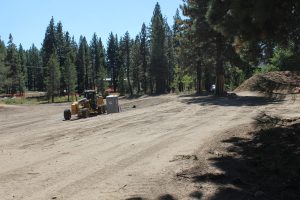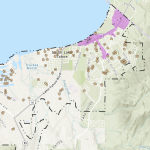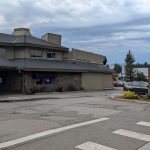Cannabis tax rates, emergency shelter and mid-town area plan: city council updates
SOUTH LAKE TAHOE, Calif. – On Tuesday, the South Lake Tahoe city council met with a particularly long agenda to make decisions on the cannabis tax rate, emergency shelter and warm room and the Mid-Town area plan, among other items, some of which were delayed from previous meetings.
Proclamations
The Daughters of the American Revolution and Access Tahoe both received proclamations for September, one for a week and one for a month.
September 17-23 was recognized as Constitution Week, which was accepted by the Daughters of the American Revolution. Jennifer Bechdel, regent for the local chapter, received the proclamation, which asked citizens to “reaffirm the ideals the Framers of the Constitution had… by vigilantly protecting the freedoms guaranteed to us through this guardian of our liberties.”
“Next year is 250 years for our country becoming what it is, so get ready for a really exciting year,” said Bechdel.
Angie Reagan and Rev. Nathan Wheeler received the proclamation recognizing September as Suicide Prevention and Recovery Month. The proclamation noted that the CDC recognizes that suicide is the 10th leading cause of death in the United States.
Wheeler said, “We know just using the word ‘suicide’ can save a life. I’m grateful to live in a city that wants to create a world where no one loses hope, and no one is alone.”
Reagan criticized the city, El Dorado County and Barton Health for not seeing improvement in addressing suicide and substance abuse. In 2024, there were 28 suicides and 28 overdoses according to the El Dorado County Sheriff’s office. In Barton’s 2024 report, 22.4% of the community rated their mental health as fair or poor and 82% of people said mental health was a major problem in the community.
“These aren’t just numbers, they are our neighbors… they are people who should still be here. People we grieve, people whose presence and gifts made the world better,” said Reagan, who said she has struggled with suicide and now volunteers for suicide prevention groups. “Please care, act, do something… despair may grow in silence, but hope grows in community.”
City manager employment agreement
City manager Joe Irvin’s contract was set to expire on April 14 next year, and Irvin indicated his interest in extending his contract. In a previous closed session, the council considered the amendments to his contract, which would extend his term for six years, remove outdated provisions and modify the performance evaluations to once a year rather than every six months.
Councilmember David Jinkens and Mayor Pro Tem Cody Bass both commended Irvin’s work in changing the culture of the city, his leadership and commitment to the city. Councilmember Scott Robbins said that the six-year contract, which extends beyond the political cycle, would provide more stability in the city.
Mayor Tamara Wallace, who was on the council that elected Irvin, said, “I couldn’t be happier with our choice. It has proven out every single time.” The motion to extend his employment agreement passed unanimously.
Cannabis tax rate discussion
Back in 2022, Measure G passed and replaced the community benefit fee with the cannabis business and professions tax. The current rate is 6% of gross receipts on retail, distribution and manufacturing, and the city collects about $9000,000 annually in revenue from four licensed businesses. They also fund a public safety mitigation fee and public safety license fee, which pays for one dedicated officer who oversees cannabis regulatory compliance.
The state of California imposed an excise tax that increased cannabis retail sales tax from 15% to 19% on July 1. While Assembly Bill 564 would have prevented the increase from going into effect, the bill is still pending in Senate.
However, cannabis businesses in town have said that the tax is increasing on the state side. In a letter written to council from Cannablue owner Alex Gosselin and CEO Jess Carlson, they noted that cannabis consumers would be paying 51.88% more in taxes than they did in 2020.
Gosselin and Carlson asked to lower the local cannabis tax from 6% to 1% to remove the burden from residents to shoulder the increased prices. City staff indicated that reducing to a 1% rate would lead to an estimated $750,000 revenue loss for the city.
During public comment, Carlson and other attendees supported reducing the tax. They cited the medical benefits of cannabis, especially for disabled people and veterans, fairness for business owners in town and the competitive nature of the business as compared to Nevada or Meyers. Several also highlighted the safety aspect of buying from a dispensary rather than from non-licensed sources.
Mayor Pro Tem Bass recused himself from this item and spoke during public comment in support of lowering the tax.
Councilmember Keith Roberts said that he was sympathetic to the challenges, but was on the fence. “Are we opening up Pandora’s Box? Where does it stop? What other businesses will ask us to reduce things so they can sell their product cheaper, just because their customers enjoy it?” Roberts also said that nonprofits on town benefit from the cannabis revenue grant.
Councilmember Scott Robbins urged the council to continue improving their lobbying efforts, as the state excise tax is far higher than the city’s tax. He also raised a question regarding the public safety outcomes and the cannabis grant’s premise, which were to mitigate public safety and negative impacts of the industry. “We ourselves have failed utterly to identify negative impacts—we can’t see them in the data, we don’t see them in crime,” said Robbins.
Roberts said that he was interested in removing the mitigation fee and was interested lowering the tax to 3% and 0% for medical users.
Wallace said she was also in favor of reducing the tax, but that if it went below 3%, that the city should not continue the cannabis grant program. After some discussion, Irvin said that he wanted to focus the conversation on the tax rate rather than the grant program, as they would consider that in future budget items.
Robbins made a motion to direct staff to establish a new tax rate of 3%, seek out a 0% tax rate for medical cannabis, eliminate the public safety mitigation fee and lobby for changes at the state and federal level. The motion passed unanimously.
Grant applications for Complete Streets
The Tahoe Regional Planning Agency (TRPA) opened up their regional grant application for projects, and staff requested council for authorization on two projects: the Stateline Complete Streets project and Johnson Boulevard Complete Streets program, which they would request $2.7 million and $2.4 million for respectively.
The Bicycle Advisory Committee requested the city council to direct staff not to apply for this grant, as they are interested in getting funding for the South Tahoe Greenway and Upper Truckee Bridge, which would connect Barton Hospital to the Dennis Machida Greenway. However, associate transportation planner Emily Dougherty said that staff felt that the regional grant was key in completing funding for the Complete Streets projects.
Robbins moved to authorize staff to apply for the $2.7 million grant for Stateline, which has higher foot traffic than Johnson Boulevard, as well as supporting the Tahoe Transportation District’s letter of support. The motion passed unanimously, with Bass recused due to his membership on the TRPA.
Mid-Town Area Plan
In the 2023-2028 strategic plan, there was a priority item to increase Mid-Town revitalization support, which the city staff has collected data, stakeholder and public outreach on to create the Mid-Town area plan. Two primary goals were to implement policy and design standards supporting all housing types and to emphasize the area as an arts and culture center.
For housing, the plan proposes an increase of height up to 56 feet, though some of the community feedback indicated they wouldn’t want that height in each area. It also proposes expanding areas for multifamily dwelling use, advocating for a higher market rate density, implementing a minimum density and exploring a mixed income density approach while incorporating TRPA Phase 2 housing amendments. The plan will lastly include directions to explore public parking visibility and accessibility and identify new locations for parking.
For arts and culture, the plan is looking into expanding light industrial uses of an artistic nature, including printing and publishing, small scale manufacturing, a small-scale kitchen and makerspace. It also proposes lighting exemptions for public art installations, exploring funding sources for public art, a commercial floor area exemption for outdoor dining and emphasizing the importance of third places.
The plan will also explore enhancements to recreation assets, access to public services and the creation of a walkable “locals’ downtown.” This could include a Trout Creek riverwalk and Palmira Avenue bike boulevard.
Wallace said that she believes that the city should consider pushing its agenda on housing, especially regarding increased density, which has sparked conversations between the TRPA and the city.
Robbins expressed concern about there being increased density in the plan without provisions that the increased density wouldn’t go to luxury condos or Airbnbs.
Robbins voted against the resolution, but with two votes from Roberts and Wallace, it passed, Bass was recused from the item and Jinkens had to leave the meeting.
Emergency shelter/warm room and Tahoe Coalition for the Homeless
Since 2023, unsheltered homelessness has decreased by 69%, but there has been an increase in hotline calls for families experiencing homelessness, and Barton Health and the police department have both expressed a need for sheltering unhoused individuals that they interact with.
Several council members have expressed an interest in a shelter or warm room, which would vary significantly in cost. A warm room would cost $150,000 to $200,000 annually and run from November to April, with volunteers and paid staff for 25 beds. An emergency shelter would run with paid staff and have 15-60 beds, but would require a program manager and operations, putting the cost at $200,000 to $2 million annually, which is how much it costs for the El Dorado County navigation center.
The council was in unanimous agreement in support of shelter services, and suggested they might also need other programs to address unsheltered people such as a motel voucher program. That became part of the motion directing staff to pursue establishing a motel voucher program in partnership with local and regional stakeholders, which passed unanimously.
The Tahoe Coalition for the Homeless (TCH), which provides many services to unhoused people in the city, had a proposed Pay for Success agreement with an amount not to exceed $40,000. TCH used to run the warm room through private donations and volunteers, and now has 14 beds at the Red Lodge which will be converted into medical respite units.
Erick Asbury was the sole public comment saying that he felt that this was the wrong place to spend money on.
Council, however, felt that the item was particularly important and voiced their support for the TCH, the progress towards a shelter and the work that the TCH does. The motion passed unanimously.
League of California Cities conference
Jinkens is the city council representative for the League of California Cities and said he would represent as the voting delegate before he left the city council meeting. Despite public comment from Asbury asking for Robbins to not be selected as the alternate, Robbins volunteered himself and was approved unanimously in a motion.
Councilmember reports and comments
Roberts asked if council would be interested in opposing Proposition 50, also called the Election Rigging Response Act. Wallace said that she would be interested in getting further information on it before making an official comment.
The next city council meeting will take place on September 23.
Eli Ramos is a reporter for Tahoe Daily Tribune. They are part of the 2024–26 cohort of California Local News Fellows through UC Berkeley.

Support Local Journalism

Support Local Journalism
Readers around the Lake Tahoe Basin and beyond make the Tahoe Tribune's work possible. Your financial contribution supports our efforts to deliver quality, locally relevant journalism.
Now more than ever, your support is critical to help us keep our community informed about the evolving coronavirus pandemic and the impact it is having locally. Every contribution, however large or small, will make a difference.
Your donation will help us continue to cover COVID-19 and our other vital local news.










